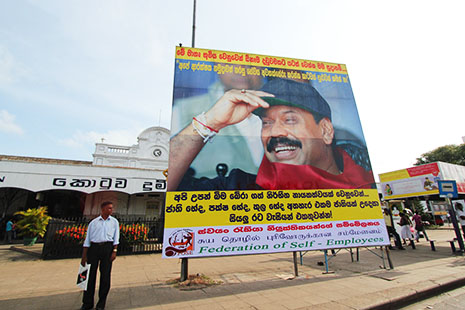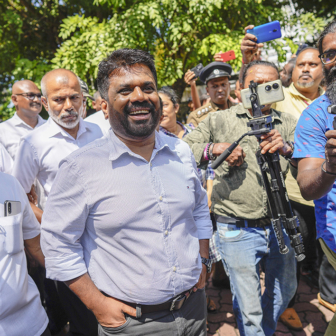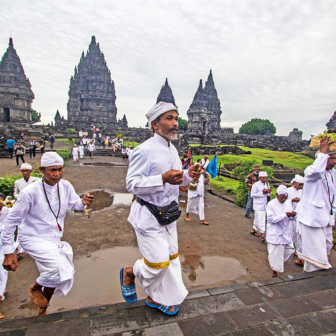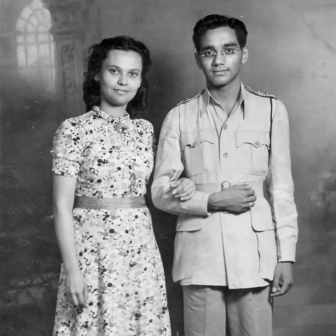WALKING the streets of Pettah – the oldest district in Colombo – I could see little evidence of the violence that took place in 1983, at the beginning of Sri Lanka’s twenty-six-year civil war. Pettah (pettai is a Tamil word for “outside the fort”) was once a home to Colombo’s Tamil community, but in July of that year hundreds were killed in retaliation for Tamil separatists’ killing of thirteen Sri Lankan soldiers in the northern district of Jaffna. The war between the majority Sinhalese Buddhists and minority Hindu Tamils would only end in May 2009, with the defeat of the Tamils.
In the last few years – and even before the end of the war – some Tamils have started venturing back to Pettah, this colourful, noisy and chaotic neighbourhood of street markets, endless lottery stands, bazaars and eateries. But Tamils are still a minority here. The horrifying memories of 1983 have faded, but they have not disappeared. The same can be said of the roots of this conflict. As Mala Liyanage, the Executive Director of the highly respected Law and Society Trust, a Colombo-based human rights organisation, told me recently, “the war has ended but the conflict remains.”
To the casual observer, though, postwar Colombo seems to have recovered its normality. Apart from a few hostile-looking soldiers posted in key places around the city – the crumbling train station, banks and public offices, and along some strategic points of the glitzy waterfront Galle Face – the military’s deployment is discreet. And tourists, anxiously awaited by tuk-tuk drivers, shop owners and hotel concierges, are returning too.
The less glossy reality of postwar Sri Lanka was splendidly summed up by former president Chandrika Kumaratunga who, in a speech at the Sri Lanka Foundation Institute in July, said that “although we have won the civil war, we have not even begun to win the battle for peace.” She described Sri Lanka as a “terribly divided nation” in which “Sinhalese Buddhist identity is projected as the exclusively legitimate one, with the right to dominance over the State and the body politic and the attendant privileges.”
Her speech was an unmistakable criticism of President Mahinda Rajapaksa, who came to power in 2005 with a “war for peace” agenda. Rajapaksa has been unwilling to implement a credible postwar agenda of peace and reconciliation. Instead, he has deepened the ethnic conflict with his triumphalist, authoritarian and Sinhalese nationalist course of action. This has produced a scenario where – as Jonathan Goodhand and Benedikt Korf observe in the recent book, Conflict and Peacebuilding in Sri Lanka: Caught in the Peace Trap? – “an inclusive and just political settlement remains a distant prospect.”
PRESIDENT Rajapaksa’s broad smile and moustachioed face can be seen just about everywhere in the streets of the capital – in posters adorning a new primary school, a road that has been widened, a new building or perhaps an extension of a street market. These street portraits are the images of a war-winning leader – and it’s certainly true that Rajapaksa won the civil war and utterly destroyed the Liberation Tigers of Tamil Eelam, one of the most vicious and suicidal separatist movements in the world.
But in victory, as many Sri Lankan commentators have said, Rajapaksa has not been magnanimous. And why would he be? His non-reconciliatory, anti-Tamil agenda is widely supported by Sri Lanka’s Buddhist Sinhalese majority, providing a vivid example of what Alexis de Tocqueville was referring to when he wrote of the “tyranny of the majority.”
The Buddhist Sinhalese comprise three-quarters of Sri Lanka’s population. They are vital to Rajapaksa’s political future. He is highly popular among them. He is also popular with the very influential Buddhist religious clergy. (In 2009, shortly after the massacre that ended the war, President Rajapaksa was blessed at the Temple of the Tooth, Sri Lanka’s most revered Buddhist shrine.) You don’t need to dig too deep to appreciate that despite his authoritarianism and his nepotism – he has three brothers and other relatives in key government posts – his anti-Tamil postwar narrative is widely popular, even among some non-Buddhists.
Abdul – a Muslim Sri Lankan in a Che Guevara T-shirt – is among the nearly 60 per cent of the population who think positively of Rajapaksa’s administration. A migrant construction worker in Saudi Arabia, he, his wife and their twelve-year-old daughter are on platform two of Colombo’s train station, heading for Kandy. “We are going to see relatives,” he told me in a cultivated English accent (“My bosses are Brits”).
Abdul thinks well of President Rajapaksa and he has not much time for what he calls “Tamil propaganda.” He has seen Sri Lanka’s Killing Fields, British Channel 4’s shocking exposé of the bloody final Sri Lankan army offensive against the Tamil Tigers, involving rape, executions and the indiscriminate killing of women, the elderly and children. (The documentary was shown in Australia on Four Corners in July this year.) But he didn’t believe a bit of it. “You know, you can’t trust that,” he says. His wife, holding the hands of her daughter, nodded.
Heard time and time again here in Sri Lanka, this version echoes the government’s view that, while some civilians were killed, the numbers were grossly inflated and based on Tamil propaganda. Last May, a UN independent investigation concluded that the video of the killing shown in Channel 4 was authentic.
As Mala Liyanage from the Law and Society Trust says, “there is no demand from the majority community for reconciliation.” It is also clear that reconciliation will be unattainable while deep ethnic division still exists in this country. A survey conducted by the independent Colombo-based Centre for Policy Alternatives reveals that ethnic division characterises postwar Sri Lanka and that a political solution will be needed to end this problem.
But the political will is lacking. While there are “talks between the Government and the Tamil party – the Tamil National Alliance – there is no progress,” says Liyanage. It is a process that “should engage all political parties.” Reconciliation will only be achieved when accountability for excesses committed during the war is recognised, she says, and a “credible investigation is opened that recognises the suffering of people in the north and east,” where the non-Sinhalese communities are concentrated.
There is an official reconciliation initiative, though, set up in 2010 by President Rajapaksa. It goes by the name of the Lessons Learnt and Reconciliation Commission, or LLRC, a sort of truth and reconciliation process. But according to Kasun Ubayasiri, a Sri Lankan journalist and academic, it is “woefully inadequate.” Dr Ubayasiri told me that the commission has been used “largely as a strategic counter manoeuvre against calls for an independent international inquiry.” In his view, the LLRC, which is expected to submit its final report in November 2011, is “limited in scope and lacks basic transparency.”
WHILE the Tamil National Alliance has formally abandoned its quest for a separate Tamil state, it has not abandoned a political struggle for regional autonomy. “The demand for regional autonomy through federalism and the merger of Northern and Eastern provinces, creating a single Tamil dominant province are unlikely to be met in postwar Sri Lanka,” says Dr Ubayasiri.
Tamils’ ethnic identity and equal rights are unlikely to be recognised either. “No Sinhalese majority government will grant equal rights to the Tamils,” says an editorial of the latest issue of Human Rights Review, published by Colombo’s Institute of Human Rights. “As long as the Rajapaksa regime holds power there will be no solution to the ethnic problem.”
According to the legal scholar Asanga Welikala, “the regime’s majoritarian ideological foundations result in a populist and authoritarian approach to government, which is incapable or unwilling to regard as legitimate Tamil (and other minorities’) political aspirations to autonomy, recognition and representation.” And in a damning report published in July, the International Crisis Group argued that “the country is yet to see any semblance of compromise or inclusiveness.”
At the end of August, President Rajapaksa lifted the repressive emergency regulation that has curbed civil and political rights for most of the last three decades. This regulation – regarded by the international community as a serious obstacle to reconciliation and peace – gave the army indiscriminate power for warrantless searches and arrests. The government has relied on this regulation to jail thousands of Tamils without trial.
Mala Liyanage doesn’t believe the president’s announcement was a genuine effort to return Sri Lanka to normality. She points out that the Prevention of Terrorism Act 1978, which overrules the fundamental rights enshrined in the constitution, will remain in force. So too does the controversial High Security Zones regulation, which has allowed the government to militarise Jaffna and other parts of the north and east of Sri Lanka. As Liyanage puts it, “Many aspects of daily life in the country are controlled by the armed forces.”
The military reinforcement in these areas is an “imposition of Sinhalese presence in the Tamil homeland,” according to Ubayasiri. The Rajapaksa government has appointed Major General G.A. Chandrasiri, a retired Sinhalese army officer who served as the Jaffna Security Forces Commander from December 2005 to January 2009, as the governor of the Northern Province. “While he may have abandoned his military fatigues it is unlikely the Jaffna Tamils would see him as anything but a Sinhalese army officer from the south,” says Ubayasiri.
If reconciliation and long-lasting peace are the aspirations in Sri Lanka then neither the introduction of new draconian laws nor the military occupation of Jaffna are the right steps. People in this region are afraid of the military. Women – who, with men in prison or dead, now head many households – fear for their safety; military frequently knock on doors to check on former militants.
Paramilitary groups aligned with the government and armed forces continue to terrorise locals. “The authorities look the other way when this happens,” I am told. The number of disappearances and killings are certainly greatly reduced, but they still occur.
For Tamils, the militarisation of their homeland is not only a threat to their physical security, it is also a threat to their identity. As one Tamil activist (who requested anonymity for security reasons) tells me, “Behind the military comes the Sinhalese settlers; it is ethnic cleansing.” Jaffna, the ancestral homeland of Tamils, has always been the last frontier of Sinhalese nationalist aspirations and imagination.
And perhaps Tamils have good reasons to be worried. Last year during a memorial for the 2004 tsunami, Jaffna schoolchildren were forced to sing the national anthem in Sinhalese. This was not only an attempt to humiliate the defeated; it also reinforced Sinhalese as the only official language in the country. It is intriguing – and perhaps simply a coincidence – that on 19 September Sri Lanka Telecom launched phase 1 of its i -Sri Lanka project in Jaffna to provide high-speed internet between the north and the south. The project is labelled “One Country One Voice.”
Meanwhile, the small but comfortable international airport in Colombo is undergoing a major refurbishment: new lounges, new shops, new departure gates and even a new statue of Buddha unveiled by the ubiquitous President Rajapaksa last August. The airport is the jewel in the crown of his administration. It will, he promised, “welcome 2.5 million tourists in 2015.” (The official figure for 2010 was 654,476.) But what this country really needs from its president is an assurance that the war has really ended and peace has begun. •




